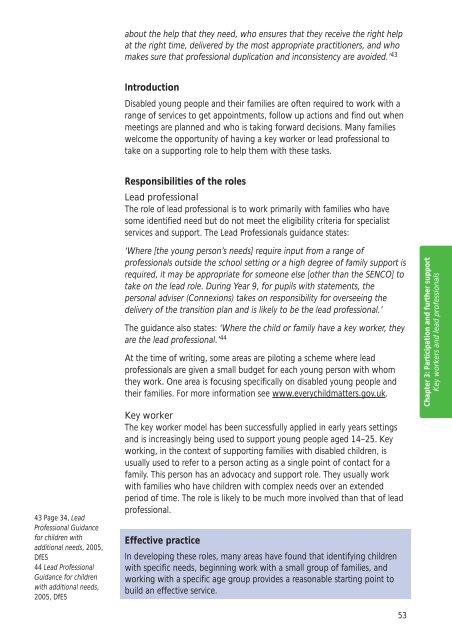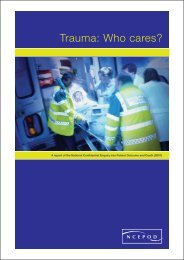A Transition Guide for All Services - Transition Information Network
A Transition Guide for All Services - Transition Information Network
A Transition Guide for All Services - Transition Information Network
- No tags were found...
You also want an ePaper? Increase the reach of your titles
YUMPU automatically turns print PDFs into web optimized ePapers that Google loves.
about the help that they need, who ensures that they receive the right helpat the right time, delivered by the most appropriate practitioners, and whomakes sure that professional duplication and inconsistency are avoided.’ 43IntroductionDisabled young people and their families are often required to work with arange of services to get appointments, follow up actions and find out whenmeetings are planned and who is taking <strong>for</strong>ward decisions. Many familieswelcome the opportunity of having a key worker or lead professional totake on a supporting role to help them with these tasks.43 Page 34, LeadProfessional Guidance<strong>for</strong> children withadditional needs, 2005,DfES44 Lead ProfessionalGuidance <strong>for</strong> childrenwith additional needs,2005, DfESResponsibilities of the rolesLead professionalThe role of lead professional is to work primarily with families who havesome identified need but do not meet the eligibility criteria <strong>for</strong> specialistservices and support. The Lead Professionals guidance states:‘Where [the young person’s needs] require input from a range ofprofessionals outside the school setting or a high degree of family support isrequired, it may be appropriate <strong>for</strong> someone else [other than the SENCO] totake on the lead role. During Year 9, <strong>for</strong> pupils with statements, thepersonal adviser (Connexions) takes on responsibility <strong>for</strong> overseeing thedelivery of the transition plan and is likely to be the lead professional.’The guidance also states: ‘Where the child or family have a key worker, theyare the lead professional.’ 44At the time of writing, some areas are piloting a scheme where leadprofessionals are given a small budget <strong>for</strong> each young person with whomthey work. One area is focusing specifically on disabled young people andtheir families. For more in<strong>for</strong>mation see www.everychildmatters.gov.uk.Key workerThe key worker model has been successfully applied in early years settingsand is increasingly being used to support young people aged 14–25. Keyworking, in the context of supporting families with disabled children, isusually used to refer to a person acting as a single point of contact <strong>for</strong> afamily. This person has an advocacy and support role. They usually workwith families who have children with complex needs over an extendedperiod of time. The role is likely to be much more involved than that of leadprofessional.Effective practiceIn developing these roles, many areas have found that identifying childrenwith specific needs, beginning work with a small group of families, andworking with a specific age group provides a reasonable starting point tobuild an effective service.53Chapter 3: Participation and further supportKey workers and lead professionals
















